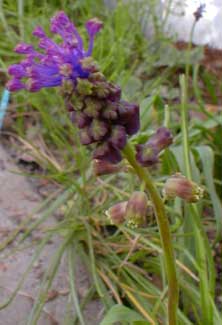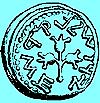
Tassel Muscari; aka:
Tufted Grape Hyacinth,
Hairy Muscari,
Edible Muscari,
or Cipollini
"Children with hyacinth's temperament
don't know better as they grow older;
they merely know more."
-Saki
1870-1916
1870-1916
The popularity of the cultivar Muscari comosum 'Plumosum,' or Tufted Grape Hyacinth, had for a long time displaced the normal wild M. comosum, or Tassel Hyacinth, which had become a specialty bulb item difficult to track down. But in 2004 this heirloom geophyte was distributed in vast numbers throughout temperate zones. If it is well enough received it is apt to be a common autumn offering for some while to come.
It is by no means new to gardening generally as it has been a gardened in southern Europe since 1596, & in England since at least 1612.
It may have fallen from popularity for so long because it is potentially invasive in some areas, whereas its fluffily plumed cultivar is restrained. The tassel hyacinth has escaped from cultivation in Oregon, Kentucky, Pennsylvania, Illinois, Georgia, North Carolina, & a few other states.
For a few centuries it has had a similarly invasive pattern in Europe, extending itself northward from its original habitats around the Mediterranean; & it now also grows wild in southwest Australia. So as one might expect, in the garden it very easily naturalizes & increases.
The species is vastly hardier than its popular cultivar & can adapt to sun, partial shade, or a great deal of shade; moist well drained soil, or droughty conditions; & is cold hardy to USDA Zone 4. It likes acid-neutral to slightly acidic soil either sandy, clayey, rocky, or loamy, & can thrive in comparatively harsh conditions like along the base of hedgerows, open fields of short grass, or neglected roadsides. It is not especially liked by deer.
About the only condition that will kill it would be boggy summer or winter conditions that rot the bulbs. Also, if grown in extremely poor soil, the bulbs may not be able to adequately recharge so will bloom excellently the first year then peter out over time, so their capacity to survive in the lousiest conditions might in severe cases keep them from naturalizing.
Even in imperfect conditions that don't permit it to self-seed well, the bulbs will be reproducing offsets, & can be dug up perhaps every third or fourth year for division. More rapid increase can be induced by dividing every other year. But if neglected many years they will retain their flowering strength even with the bulbs increasingly crowding themselves.
When division is desirable, it is best done mid-summer as the leaves are dying back. The largest bulbs can be replanted immediately, but to maximize survival, the tinier offsets should be protected in coldframes or pots for about a year before going back into the garden.
It is very small, sometimes only five or six inches in height, at most ten inches to a foot to the tip of the flower stem. Its foliage is a floppy-sloppy turf, & even the flower stems can lean this way & that, though they look quite natural rather than tippy for doing so.
For the best gardened strains, when first in flower mid to late May, it has not only the partially closed fertile florets reminscent of a bunch of grapes purple-brown to olive-brown, but atop these florets are tall slim sterile deep violet flowers that look like tassels, a very fancy headdress, or Al Sharpton's hairdo. As the "bunch" of sterile florets beneath the tassels age & the stem lengths, these turn fawn-colored & spread out along the stem, but the tassel atop remains bright violet-purple.
The blooms are sometimes said to have a light musky scent, but ours are entirely scentless, possibly because they have lost some of their wild scent in the mass-production process; or because the scent they might develop in warmer Mediterranean climes is not as likely to be concentrated enough to be significant further north; or perhaps because rumor of their musk has transferred incorrectly from the most wonderfully scented M. muscarimi.
A dozen smallish Tassel Hyacinth bulbs were planted inside the dripline of an American Witchhazel, in & amidst cyclamens that include an unusual small-leaf sport called Cyclamen hederifolium 'Green Elf.' Twenty-five very large bulbs or double-bulbs with offsets were inserted in a larger area amidst the cyclamens & in the same general vicinity of the witchhazel. We were hoping the two sources of bulbs would produce subtly but noticeably different color shades of flowers, since there can be considerable variation especially for the fertile florets which range from fawn to purple-brown, arranged in small bunches or stretched out very thinly along each stem.
The wild tassel hyacinth is additionally known as "Edible Muscari" or served in Mediterranean restaurants as "Cippolini," reportedly tasty & bittersweet when fully cooked. When grown to eat, they are harvested when three thin leaves appear, & not permitted to bloom. For the Greek & Italian market they are cooked & canned by small commercial specialists, packed in oil & vinegar, to be used as a relish.
The cultivar 'Plumosum' reproduces too slowly to be sensibly grown for food, & a great shame to dig them up before they flower in any case; but after a few years the wild Tassel Hyacinth should be so well established in the garden that there'd be enough extras to harvest some pre-flowering spring bulbs for the kitchen.
It has also been used medicinally as a diuretic, or pounded into a paste rich in mucilage smeared on skin abrasions.
There are other Tassel Hyacinths formerly assumed to be regional variants of M. comosum but now given their own species. These include M. dionyscum sometimes sold under the cultivar name 'Epirus Giant' (1989) the largest of all muscaris at twenty inches height, originating on Mt. Grammos in the Ioannina province of northern Greece; & M. pinardisometimes sold with the cultivation name 'Pinard' (1925), from the Taurus Mountains of Cilicia in Turkey, its lower fertile florets being more reliably blue rather than the typical fawn of the common Tassel Hyacinth. These are in limited production available from very few bulb specialists.
SOME RELIGIOUS ASSOCIATIONS:
G. K. Chesterton, in a story called "The Paradise of Thieves" in The Wisdom of Father Brown (1914), introduces one character as "an ardent Catholic" & "Tuscan poet" named Muscari. I presume Chesterton knew of the associations of the genus with his own faith. In Spain M. comosum & sometimes M. neglectum are called by the common name Nazarenos, or the Nazarene's Hyacinth, & frequently seen in Cathedral gardens.A Christian folk-name for muscaris of most any species is "St. Joseph's Bells" (also applied to Snowflakes, Leucojum vernum). This name would be most appropriate for a loosely racemed species like M. comusum or M. muscarimi, because the florets can dangle more like bells rather than remaining bunched together like grapes. By comparison, another Catholic garden name, "Church Steeples," would be applied mainly to M. botryoides or M. armeniacum or other muscaris that form tight pyramidal florets that might be regarded as cathedral towers.
M. racemosum is sometimes called Ladder-of-Heaven, alluding to Jacob's vision of the stairway with angels coming & going to & from the Earth. And in Spanish it is known as Our Lord's Little Foot ("Piececillo de Senor"). This alludes to a Catholic legend, celebrated in this poem by St. Teresa of Lisieux (1873-1997):
"When Thou didst leave Thy Mother's fond embrace,The Christian associatons for the genus may have originated through Mariolatry, for just about all blue flowers have at one time or another been associated with Mary, whose garments are so frequently blue. Although M. comosum is deep violet, the majority of muscaris are blue. The Franciscan St. Hyacintha (1585-1640) was a young woman of scandalous character. She became devoted predominantly to Mary as Mother of God, & the name of Hyacintha indicates either the gem or blossom which was Mary's symbolic color.
Let go her hand;
And first, on our hard earth, Thy little foot didst place,
And trembling stand;
Within Thy pathway, then fresh rose leaves would I spread,
Their Maker's dower,
That so Thy tiny feet might very softly tread
Upon a flower."
Or, rather than through Mary, or additionally, these associations may have been inherited through the Greek demigod Hyacinthos, regarded by a few as a precursor form of the Christ, despite that the cult of Hyacinth was primarily homosexual. His name in time lost its pagan associations sufficiently to become a suitable name for Christian worshippers, priests, or saints. The Dominican St. Hyacinth (1185-1257) is a patron of Poland. He became associated with muscaris which are called jacinths in many places of Europe. His original name was Jacob, rendered into Latin as Jacinthus, which means Hyacinth.
M. comusum in particular, because it blooms a bit later than most muscaris, became the Nazarene's Muscari because it blooms at Easter. This species is in Spain knickknamed the Lent Flower ("Penitentes") identifying it with the period before Easter, or God's Nail ("Clavos de Dios") alluding to the torture of nails upon the cross. God's Nail was also an old Norse name for the Pole Star, which is very nearly overhead in Scandinavia hence thought of as the center of the sky. The God of this Nail was Thor. In Scandinavian households, the nail which held the central pillar of any house in place was dedicated to Thor, because of its similarity to God's Nail, or Polaris, which held all heaven in place.
 A shekel issued by the great rebel leader Simon bar-Kokhba, in defiance of the Romans who had banned Jerusalem from issuing silver coins, features a blossom with three pinched flowers, probably a muscari native to Israel, surrounded by the slogan "Jerusalem the Holy."
A shekel issued by the great rebel leader Simon bar-Kokhba, in defiance of the Romans who had banned Jerusalem from issuing silver coins, features a blossom with three pinched flowers, probably a muscari native to Israel, surrounded by the slogan "Jerusalem the Holy."The implication of this coin (pictured here) is that muscaris had a Jewish significance, symbolic of rebellion, before the genus was coopted by Christians. It has been suggested the shekel's muscari evoked the blossoming in the wilderness of Aaron's rod, the same rod as brought the ten plagues upon the enemy of Israel, when Israel rebelled against their slavery. This flowering came to be associated with the Tree of Life in kabbalah & in midrash.
Hyacinths, inclusive of muscaris, have been identified with Esther who protected Israel in exile, & with the Tabernacle of the wilderness which had curtains blue as grape hyacinths. Perhaps most apropos of the Tassel Hyacinth are the hyacinth-blue fringes or tassels which God instructed be worn by the children of Israel at the corners of their garments [Numbers 15:38], which the Septuagint clarifies as being hyacinth colored.